Using `onViewableItemsChanged`
You might want to know viewable items in a FlatList and are notified when viewable items are changed. For example: in list of videos, you want to automatically play a video when the video when it appears on the screen for a few seconds.
In Android, you can use findFirstVisibleItemPosition and findLastVisibleItemPosition if your RecyclerView is using LinearLayoutManager or GridLayoutManager. Besides, it provides isViewPartiallyVisible to claim if a child view is partially or fully visible. In iOS, you could use visibleCells in UITableView. React Native's FlatList component has its own powerful property: onViewableItemsChanged. This guide will show you how to use the onViewableItemsChanged and how it works under the hood.
What is onViewableItemsChanged
onViewableItemsChanged is a prop accessible to both VirtualizedList and FlatList components. When you scroll one of these lists, only a few list items can be seen on screen at any time. These visible items are the viewableItems. When the onViewableItemsChanged function is called, it returns with an array of the currently visible items, viewableItems, and an array of the items that are no longer visible, changed items.
How to use it
In this example, you will learn how to use [onViewableItemsChanged](virtualizedlist#onviewableitemschanged) and [ViewabilityConfig](virtualizedlist#viewabilityconfig) in FlatList.
- onViewableItemsChanged Example
- viewabilityConfigCallbackPairs Example
onViewableItemsChanged should be used together with ViewabilityConfig. ViewabilityConfig is the configuration you customize when the onViewableItemsChanged is called. onViewableItemsChanged is called when its corresponding ViewabilityConfig's conditions are met.
<FlatList
viewabilityConfig={viewabilityConfig}
onViewableItemsChanged={onViewableItemsChanged}
{...}
/>
viewabilityConfig = {
waitForInteraction: true,
itemVisiblePercentThreshold: 75,
minimumViewTime: 800
};
In this snippet, waitForInteractions is true. If waitForInteractions is set to true, only when the user scrolls or recordInteraction is called, FlatList will calculate the viewable items.
waitForInteraction: true,
Additionally, minimumViewTime is set to 800, and itemVisiblePercentThreshold is set to 75. This config means the item is marked as visible only if 75% or more of it is physically viewable for more than 800 milliseconds.
itemVisiblePercentThreshold: 75,
minimumViewTime: 800,
Supposed you have to do different things for items with 60% viewable region and those with 75% viewable region. You can use viewabilityConfigCallbackPairs, which is a list of ViewabilityConfig/onViewableItemsChanged pairs. In the following code, on60ViewableItemsChanged will be called when some items are at least 60% viewable for more than 600 milliseconds. In the meanwhile, on75ViewableItemsChanged will be called when some items are at least 75% viewable for more than 700 milliseconds.
viewabilityConfigCallbackPairs = [
{
viewabilityConfig: {
minimumViewTime: 600,
itemVisiblePercentThreshold: 60
},
onViewableItemsChanged: on60ViewableItemsChanged
},
{
viewabilityConfig: {
minimumViewTime: 700,
itemVisiblePercentThreshold: 75
},
onViewableItemsChanged: on75ViewableItemsChanged
}
];
How onViewableItemsChanged works
Viewable Region
The layout and viewable region information for VirtualizedList is stored in a _scrollMetrics object. Through the nativeEvent in onScroll callback, VirtualizedList can access this layout information.
const timestamp = e.timeStamp;
let visibleLength = this._selectLength(
e.nativeEvent.layoutMeasurement
);
let contentLength = this._selectLength(e.nativeEvent.contentSize);
let offset = this._selectOffset(e.nativeEvent.contentOffset);
let dOffset = offset - this._scrollMetrics.offset;
// ... more code here
this._scrollMetrics = {
contentLength,
dt,
dOffset,
offset,
timestamp,
velocity,
visibleLength
};
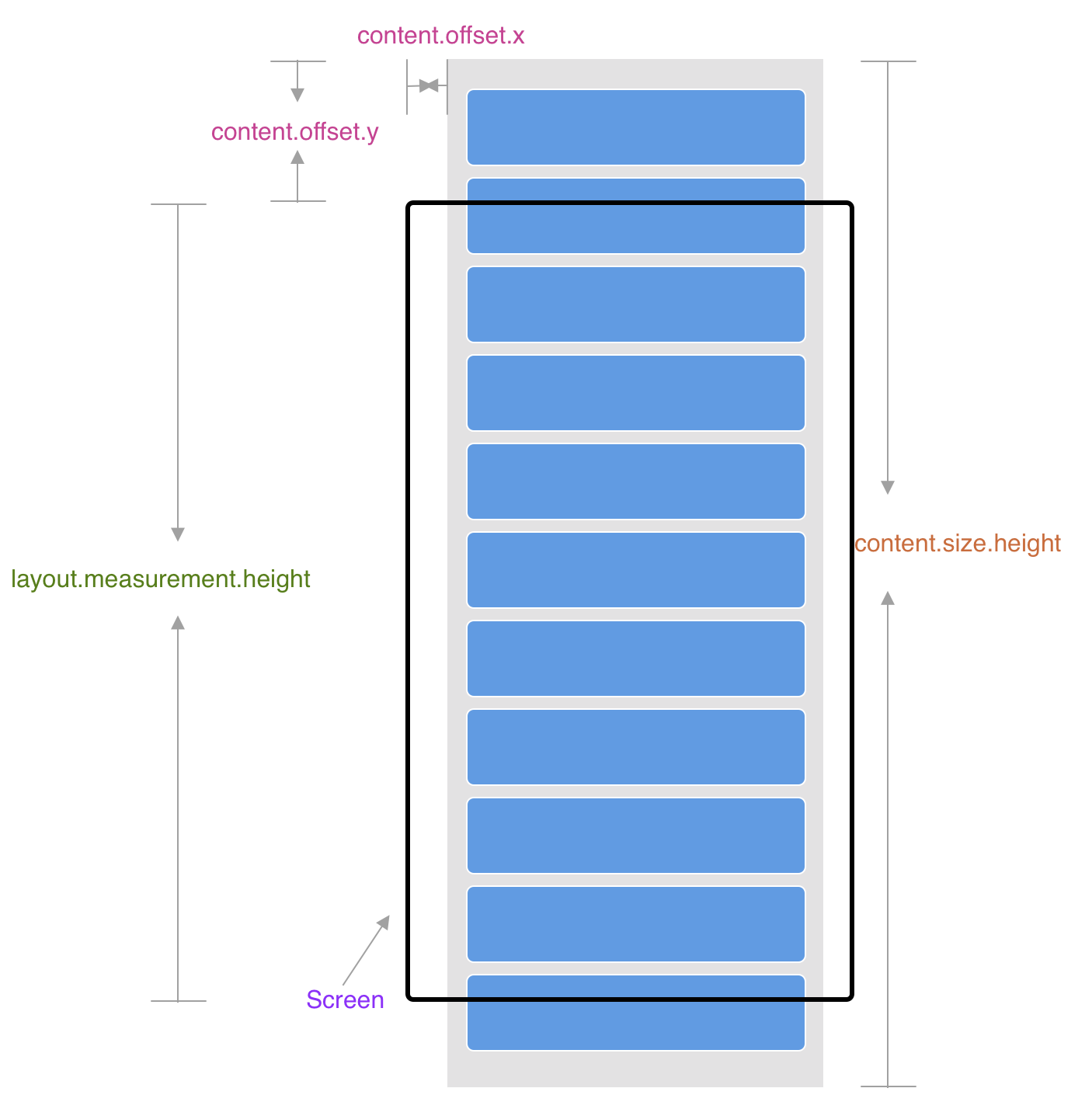
If it is a vertical VirtualizedList, the layout.layoutMeasurement.height in the nativeEvent is assigned to visibleLength, the height of viewable region.
Overview
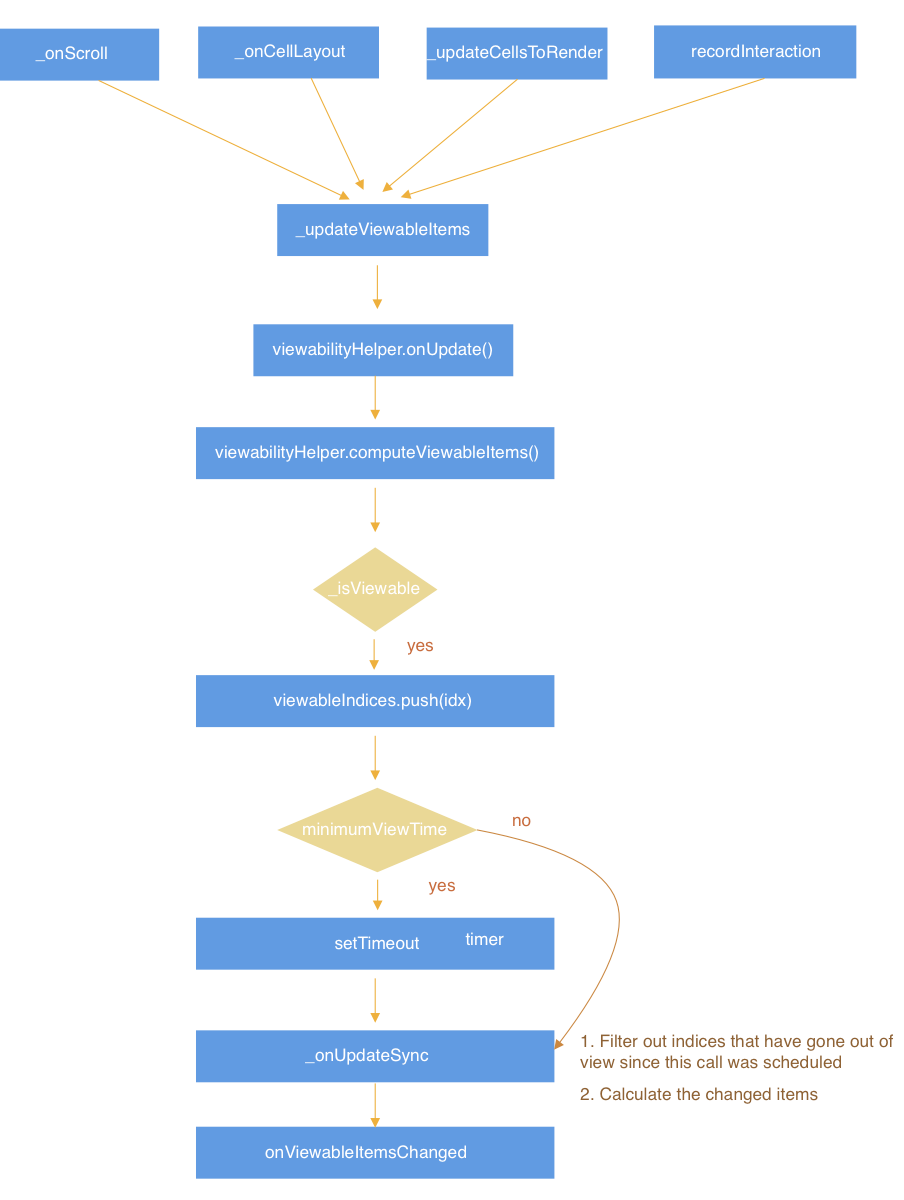
Different viewabilityConfig in one VirtualizedList
_viewabilityTuples is an array inside VirtualizedList to store ViewabilityHelper/onViewableItemsChanged pairs. This array is initialized in the constructor function.
_viewabilityTuples: Array<ViewabilityHelperCallbackTuple> = [];
type ViewabilityHelperCallbackTuple = {
viewabilityHelper: ViewabilityHelper,
onViewableItemsChanged: (info: {
viewableItems: Array<ViewToken>,
changed: Array<ViewToken>,
...
}) => void,
...
};
If you define viewabilityConfigCallbackPairs, each viewabilityConfig will be used to initialize a different ViewabilityHelper object.
if (this.props.viewabilityConfigCallbackPairs) {
this._viewabilityTuples = this.props.viewabilityConfigCallbackPairs.map(
(pair) => ({
viewabilityHelper: new ViewabilityHelper(
pair.viewabilityConfig
),
onViewableItemsChanged: pair.onViewableItemsChanged
})
);
} else if (this.props.onViewableItemsChanged) {
this._viewabilityTuples.push({
viewabilityHelper: new ViewabilityHelper(
this.props.viewabilityConfig
),
onViewableItemsChanged: this.props.onViewableItemsChanged
});
}
ViewabilityHelper is a utility class for calculating viewable items based on the viewabilityConfig and metrics, like the scroll position and layout.
As I mentioned before, in a VirtualizedList could has several ViewabilityHelper objects in _viewabilityTuples, containing different viewabilityConfig to handle different viewability conditions. Here are some important props in ViewabilityHelper.
class ViewabilityHelper {
_config: ViewabilityConfig;
_hasInteracted: boolean = false;
/* A set of `timeoutID`, used for memory management */
_timers: Set<number> = new Set();
// Indexes of the viewable items
_viewableIndices: Array<number> = [];
// A map for viewable items
_viewableItems: Map<string, ViewToken> = new Map();
}
Items' layout
In the overview graph, you can see a func _updateViewableItems called in many scenarios. For example, it is called in onScroll callback. Then, It calls viewabilityHelper.onUpdate to find out the viewable items, which appear in the viewport for VirtualizedList.
_updateViewableItems(data: any) {
const {getItemCount} = this.props;
this._viewabilityTuples.forEach(tuple => {
tuple.viewabilityHelper.onUpdate(
getItemCount(data),
// contentOffset of the list
this._scrollMetrics.offset,
// 🌟 viewportHeight
this._scrollMetrics.visibleLength,
this._getFrameMetrics,
this._createViewToken,
tuple.onViewableItemsChanged,
this.state,
);
});
}
this._scrollMetrics.visibleLengthis used asviewportHeightthis._createViewTokenis used to construct aViewTokenobject, which containsitemdata,index,keyandisViewableflag of theitem.- this._getFrameMetrics is a function to get layout information of the item cell by index. The item layout is from
getItemLayoutprop ofVirtualizedListorthis._framesmap.this._framesstores the itemKey/itemLayout pairs.
// this._frames stores the item cell layout info
{ [cellKey]: {
// offset of the item cell
offset: number,
// length of the item cell. width or height determined by the direction of the VirtualizedList
length: number,
index: number,
inLayout: boolean,
}
}
- By
this.state, you know the range of the rendered items byfirstandlastvalue.VirtualizedListupdates these two values when the rendered items are changed.
type State = {
// The range of the rendered items,
// used for the optimization to reduce the scan size
first: number,
last: number,
...
};
How to find out viewable items
In onUpdate method, it calls computeViewableItems to get viewableIndices. viewableIndices is an array of indexes of the viewable items. So, how does computeViewableItems work?
How to get the indexes of viewable items
In computeViewableItems in the ViewabilityHelper class, it iterates items from ${first} to ${last}. If an item is viewable, it will be stored in an array named viewableIndices.
for (let idx = first; idx <= last; idx++) {
const metrics = getFrameMetrics(idx);
if (!metrics) {
continue;
}
// The top of current item cell, relative to the screen coordinate
const top = metrics.offset - scrollOffset;
// The bottom of current item cell, relative to the screen coordinate
const bottom = top + metrics.length;
if (top < viewportHeight && bottom > 0) {
firstVisible = idx;
if (
_isViewable(
viewAreaMode,
viewablePercentThreshold,
top,
bottom,
viewportHeight,
metrics.length,
)
) {
viewableIndices.push(idx);
}
} else if (firstVisible >= 0) {
break;
}
}
return viewableIndices;
}
From the code, you can see the top and bottom value is related to the screen coordinate. I drew a graph to show the relationship between metrics.offset, scrollOffset, metrics.length , top and bottom. This graph will help you better understand the above code.
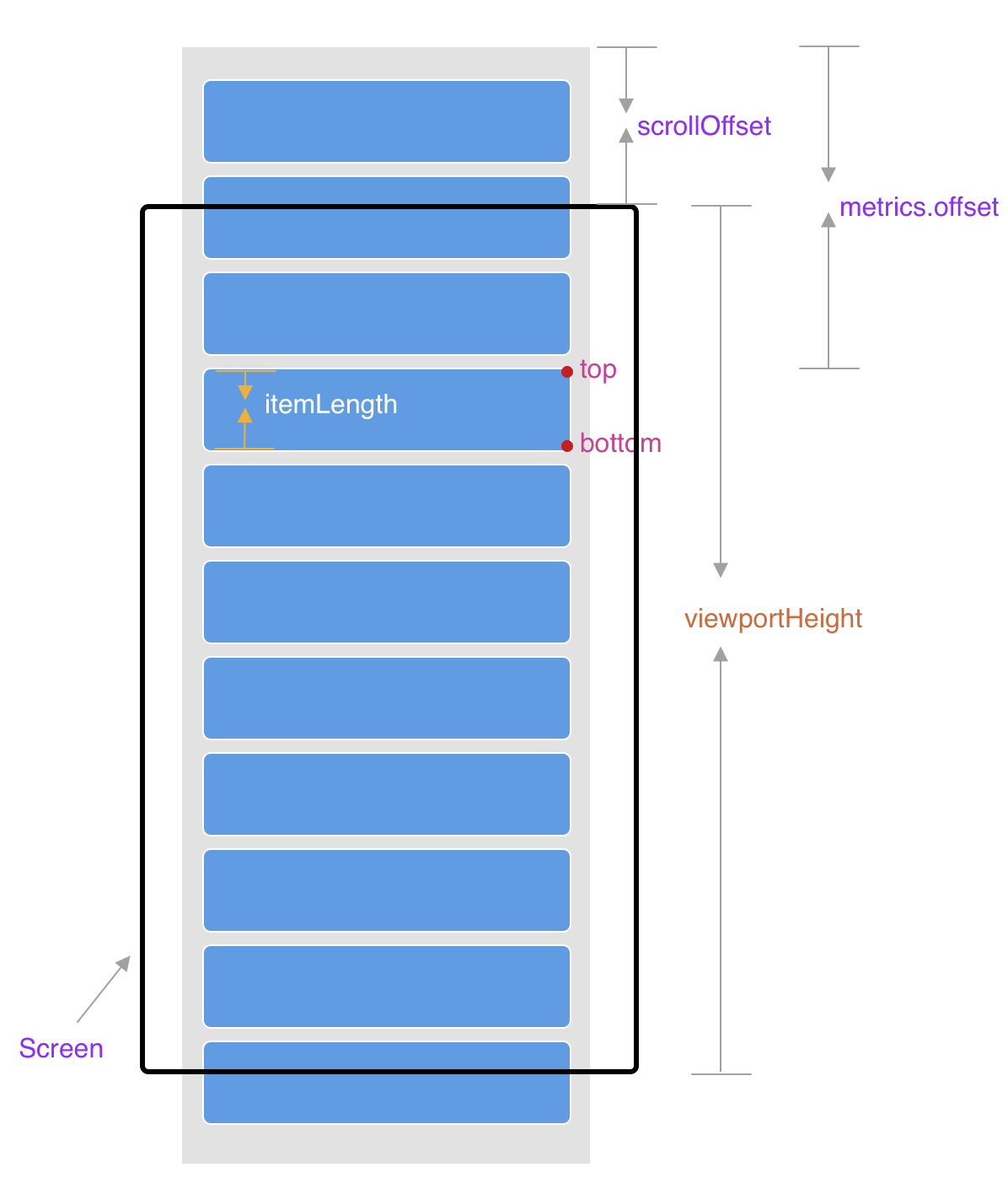
What kind of item is viewable
An item is said to be viewable when it meets the following conditions for longer than ${minimumViewTime} milliseconds (after an interaction if waitForInteraction is true):
- the fraction of the item visible in the view area >=
itemVisiblePercentThreshold. When it comes to the fraction of the item visible in the view area, you need to take care about cases shown in the following graph. RN useMath.min(bottom, viewportHeight) - Math.max(top, 0)to calculate the viewable length.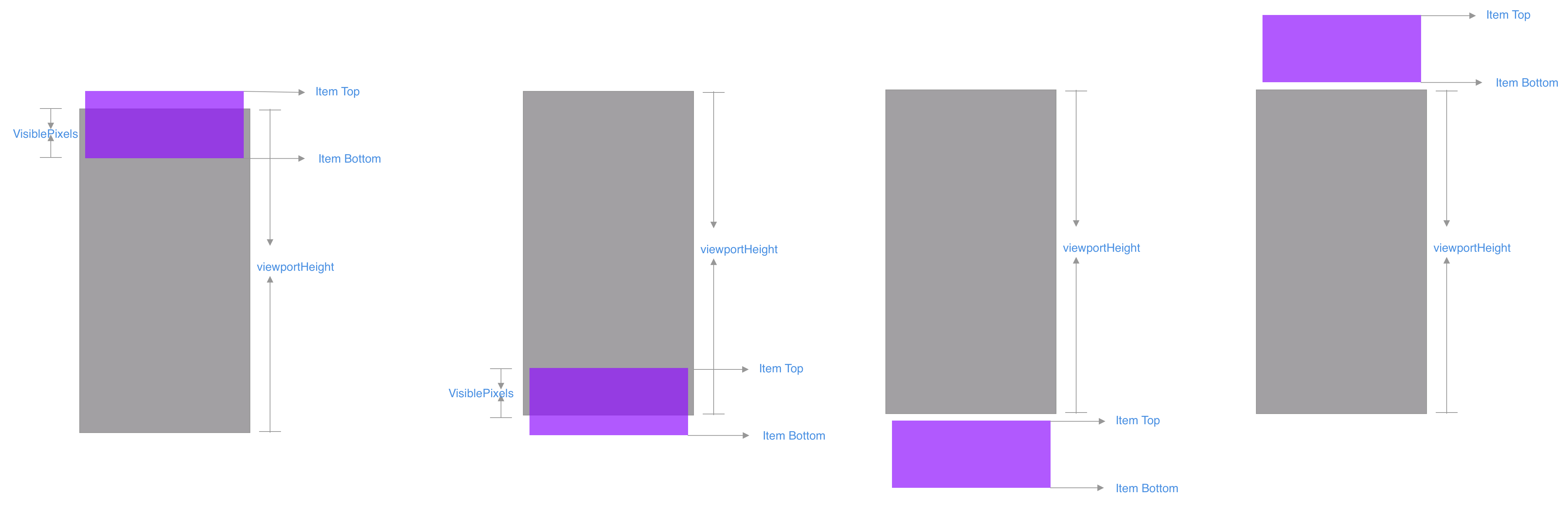
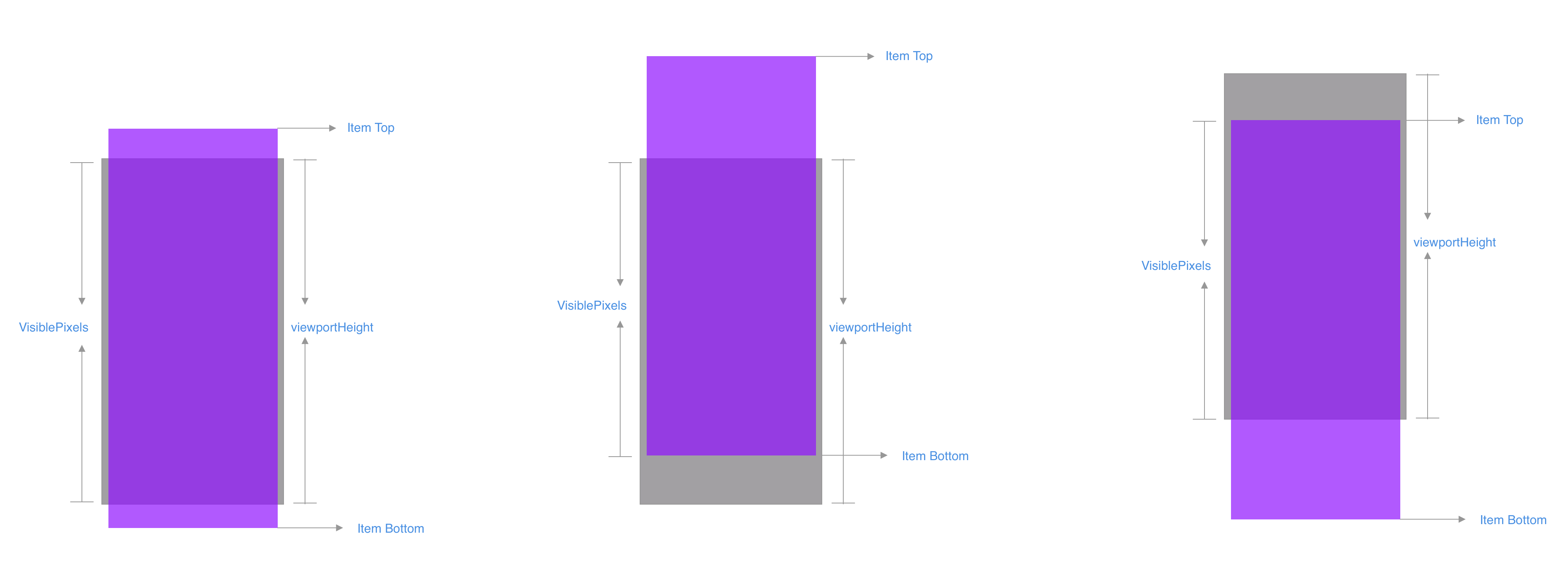
- Entirely visible on screen when the height of a item is bigger than the
viewportHeight.
function _isViewable(
viewAreaMode: boolean,
viewablePercentThreshold: number,
top: number,
bottom: number,
viewportHeight: number,
itemLength: number
): boolean {
if (_isEntirelyVisible(top, bottom, viewportHeight)) {
// Entirely visible
return true;
} else {
// Get viewable height of this item cell
const pixels = _getPixelsVisible(top, bottom, viewportHeight);
// Get the viewable percentage of this item cell
const percent =
100 *
(viewAreaMode
? pixels / viewportHeight
: pixels / itemLength);
return percent >= viewablePercentThreshold;
}
}
function _getPixelsVisible(
top: number,
bottom: number,
viewportHeight: number
): number {
const visibleHeight =
Math.min(bottom, viewportHeight) - Math.max(top, 0);
return Math.max(0, visibleHeight);
}
function _isEntirelyVisible(
top: number,
bottom: number,
viewportHeight: number
): boolean {
return top >= 0 && bottom <= viewportHeight && bottom > top;
}
_isViewable source code is here
Timer and Schedule
In onUpdate func in ViewabilityHelper, if you define minimumViewTime value, the _onUpdateSync is scheduled to be called. It is the handler of the timeout.
this._viewableIndices = viewableIndices;
if (this._config.minimumViewTime) {
const handle = setTimeout(() => {
this._timers.delete(handle);
// filter out indices that have gone out of view after minimumViewTime
// figure out which items are gone, which items are showing
this._onUpdateSync(
viewableIndices,
onViewableItemsChanged,
createViewToken
);
}, this._config.minimumViewTime);
this._timers.add(handle);
} else {
this._onUpdateSync(
viewableIndices,
onViewableItemsChanged,
createViewToken
);
}
If some items aren't longer viewable after a few seconds, ${minimumViewTime}, the _onUpdateSync func filters out these indices that have gone out of viewport.
// Filter out indices that have gone out of view after `minimumViewTime`
viewableIndicesToCheck = viewableIndicesToCheck.filter((ii) =>
this._viewableIndices.includes(ii)
);
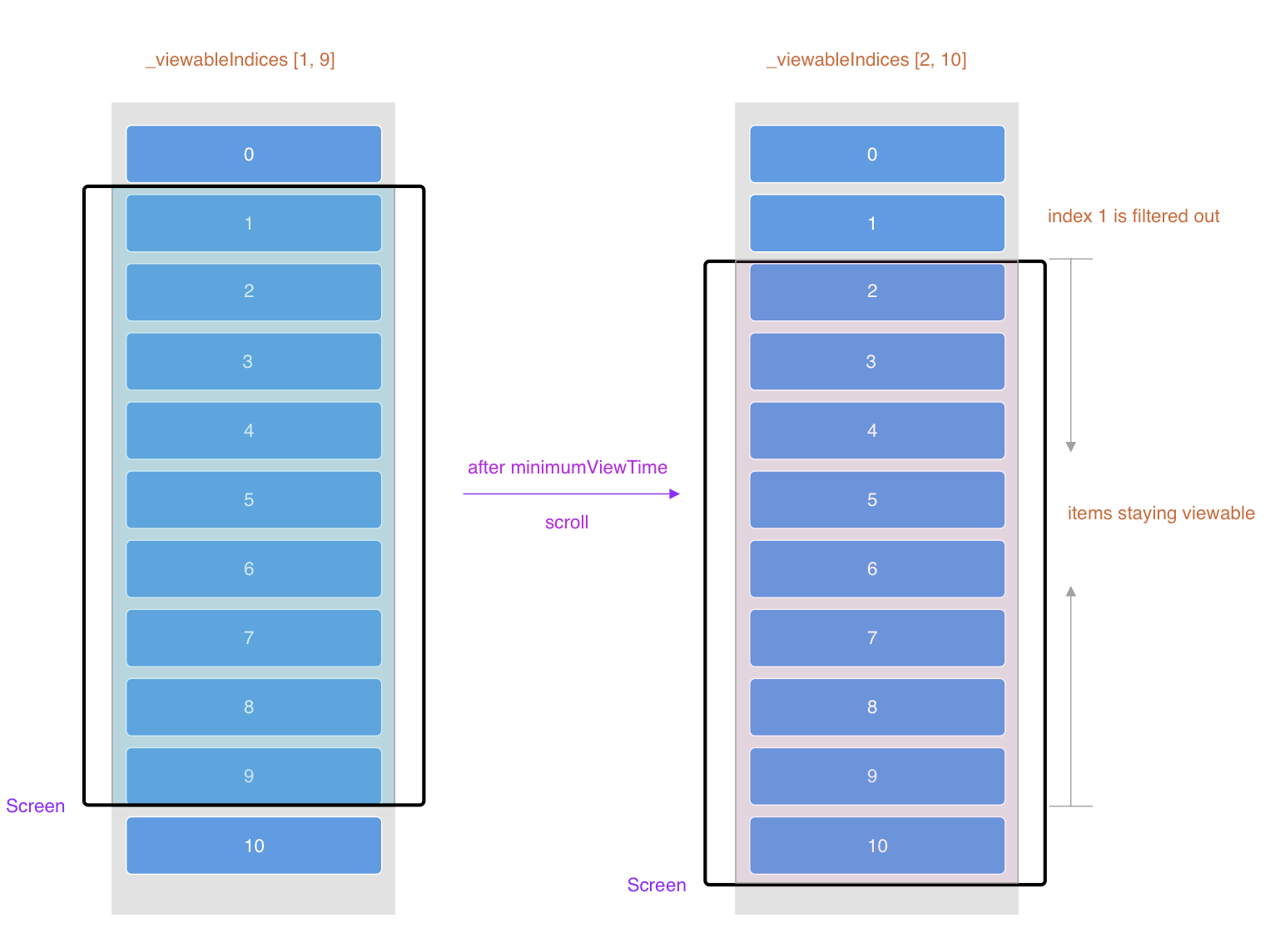
In the above graph, at first, the _viewableIndices is from 1 to 9. Then the user scrolls the VirtualizedList and the _onUpdateSync is triggered after minimumViewTime. At this moment, the current _viewableIndices is from 2 to 10. So the item indexed 1 is filtered out.
How to get changed items
Comparing with the last time when onViewableItemsChanged is triggered, at this time to trigger onViewableItemsChanged. Some viewable items will be out of the screen, some hidden items will become viewable. In _onUpdateSync function, the preItems map stores the information about previous visible items, the previous means last time when VirtualizedList calls onViewableItemsChanged. Now it has a nextItems map, which stores the information about viewable items this time. Then it figures out the changed items by comparing these two maps. Then, it calls onViewableItemsChanged, passing viewableItems and changed items.
_onUpdateSync(
viewableIndicesToCheck,
onViewableItemsChanged,
createViewToken,
) {
// Filter out indices that have gone out of view since this call was scheduled.
viewableIndicesToCheck = viewableIndicesToCheck.filter(ii =>
this._viewableIndices.includes(ii),
);
const prevItems = this._viewableItems;
// Using map, so the time complexity would be o(n)
const nextItems = new Map(
viewableIndicesToCheck.map(ii => {
const viewable = createViewToken(ii, true);
return [viewable.key, viewable];
}),
);
const changed = [];
for (const [key, viewable] of nextItems) {
if (!prevItems.has(key)) {
changed.push(viewable);
}
}
for (const [key, viewable] of prevItems) {
if (!nextItems.has(key)) {
changed.push({...viewable, isViewable: false});
}
}
if (changed.length > 0) {
this._viewableItems = nextItems;
onViewableItemsChanged({
viewableItems: Array.from(nextItems.values()),
changed,
viewabilityConfig: this._config,
});
}
}
}
